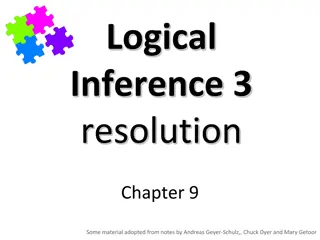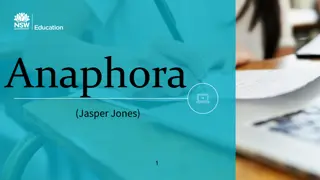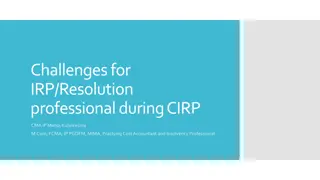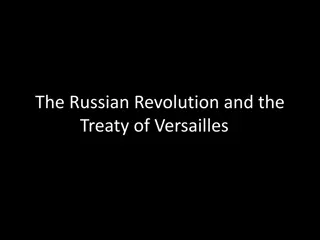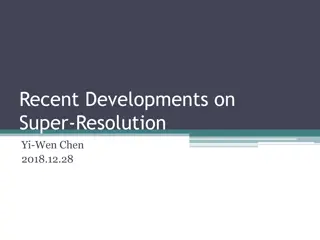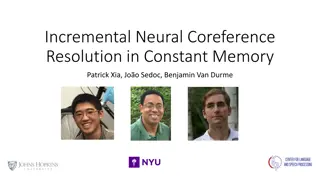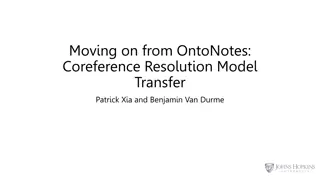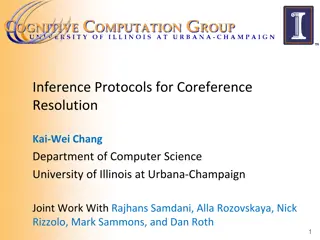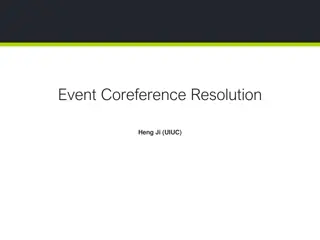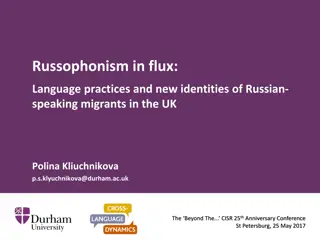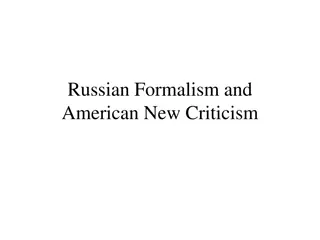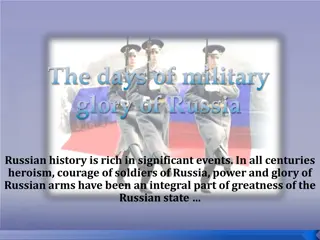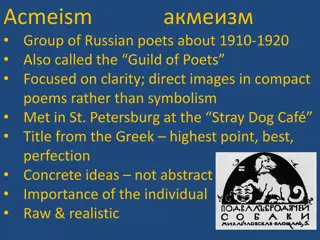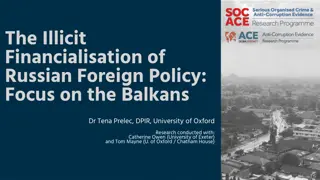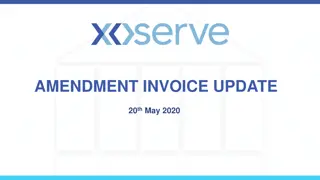Russian Anaphora and Coreference Resolution Evaluation
The Ru-Eval-2019 project evaluates anaphora and coreference resolution for Russian text. It discusses the task definition, existing corpora, and introduces a new corpus from OpenCorpora.org. The project focuses on coreference resolution to determine which mentions in a text refer to the same entity, using various layers such as mentions, coreference chains, and morphological and semantic-syntactic information. The work aims to improve language understanding and semantic processing in the Russian language.
Download Presentation

Please find below an Image/Link to download the presentation.
The content on the website is provided AS IS for your information and personal use only. It may not be sold, licensed, or shared on other websites without obtaining consent from the author.If you encounter any issues during the download, it is possible that the publisher has removed the file from their server.
You are allowed to download the files provided on this website for personal or commercial use, subject to the condition that they are used lawfully. All files are the property of their respective owners.
The content on the website is provided AS IS for your information and personal use only. It may not be sold, licensed, or shared on other websites without obtaining consent from the author.
E N D
Presentation Transcript
Ru-Eval-2019: Evaluating anaphora and coreference resolution for Russian E. Budnikov (ABBYY) D. Zvereva (MIPT) D. Maksimova, S. Toldova (NRU HSE) M. Ionov (Goethe University Frankfurt)
Plan Task definition Corpus characteristics Tagging strategy Results and Future plans
Task definition Coreference resolution is the task of determining which mentions in a text refer to the same entity. Mention is a phase referring to an object or an event. Entity is such object or event. Example: Paul looks at the building. He doesn t like it.
Existing corpora Message Understanding Conference-6 [Grishman, Sundheim 1996] English (318 texts) CoNLL-2012 Shared Task [Pradhan et al. 2012] English (2384 texts), Arab (447), Chinese (1729) Prague Dependency Treebank [Nedoluzhko 2016] English, Czech (50k sentences, >60k links) RuCor [Toldova et al. 2014] Russian (181 texts)
New corpus Source: Open Corpus of Russian Language (OpenCorpora.org) Source size: 3729 texts Tagged subset: 525 texts, 5.7k chains with 25k mentions
New corpus details Mentions layer Coreference chains layer Morphological layer Semantic-syntactic layer Semantic classes embeddings
Mentions layer Source: ABBYY Compreno (auto) Human annotators (manual) Format: Mention ID Mention offset Mention length
Mentions layer What is mention: Persons, Locations, Organizations, other named entities Key word + Identifier. Always has a referent Noun phrases Real objects or abstract concepts that are referred to further in the text Pronouns and pronoun phrases All that can have a referent (except negative, reflexive, and reciprocal ones)
Mentions layer: interesting cases Reflexive and reciprocal pronouns . * . * . Synonymous names (pseudonyms) 107- 1940 ( -60) Adjectives with referents ; ; ;
Mentions layer: interesting cases[2] Named mentions vs. Unnamed mentions , (2 mentions) , (1 mention) Descriptive noun phrases . . Descriptive noun phrases [2] . .
Coreference chains layer Source: Human annotators (manual) Format: Mention ID Mention offset Mention length Chain ID
Coreference chains layer: interesting cases Part vs Whole 1 2 . 3 . 3 . 1 , 2 . Descriptive noun phrases 1 . 1 .
Morphological layer Source: OpenCorpora (manual) Format: Token ID Token offset; Token length Token text Lemma Morph Tags
Semantic-syntactic layer Source: ABBYY Compreno (auto) Format: Token offset; Token text Parent token offset Lemma Lexical class; Semantic class Surface Slot; Semantic Slot Syntactic Paradigm
Semantic classes embeddings Source: ABBYY Compreno (trained on 800 words) Format: Semantic class ID Vector of length 200
Measures Anaphora: F-measure Coreference: MUC B-CUBE CEAF-E
Coreference track results Team muc bcube ceafe mean legacy 75.83 66.16 64.84 68.94 SagTeam 62.23 52.79 52.29 55.77 DP 62.06 53.54 51.46 55.68 82.62 73.95 72.14 76.24 DP (additionally trained on RuCor) Julia Serebrennikova 48.07 34.7 38.48 40.42 MorphoBabushka 61.36 53.39 51.95 55.57
Anaphora track results Acc soft Prec Rec F1 Acc strong Prec Rec F1 Team DP Run Full 76.30% 79.20% 76.30% 77.80% 68.10% 70.70% 68.10% 69.40% On gold 91.00% 91.40% 91.00% 91.20% 83.50% 83.90% 83.50% 83.70% Etap Legacy NSU_ai Morphobabushka 52.40% 78.70% 52.40% 62.90% 39.10% 58.70% 39.10% 46.90% 70.80% 75.70% 70.80% 73.20% 59.10% 63.10% 59.10% 61.00% 23.20% 43.30% 23.20% 30.20% 6.90% 12.90% 6.90% 9.00% best-muc-1 best_b3f1_and_ 62.90% 63.50% 62.90% 63.20% 38.80% 39.10% 38.80% 39.00% ceafe_4 best_b3f1_and_ 55.10% 57.30% 55.10% 56.20% 37.10% 38.60% 37.10% 37.80% ceafe_5 54.50% 59.40% 54.50% 56.80% 35.10% 38.30% 35.10% 36.60% Meanotek 44.40% 58.70% 44.40% 50.60% 34.70% 45.80% 34.70% 39.40% 52.40% 78.70% 52.40% 62.90% 39.20% 58.80% 39.20% 47.00%
References 1. Anisimovich K., Druzhkin K., Minlos F., Petrova M., Selegey V., and Zuev K. (2012), Syntactic and semantic parser based on ABBYY Compreno linguistic technologies. In Computational Linguistics and Intellectual Technologies. Papers from the Annual International Conference Dialogue , vol. 11, pp. 91 103. Bagga, A., & Baldwin, B. (1998, August). Entity-based cross-document coreferencing using the vector space model. In Proceedings of the 17th international conference on Computational linguistics-Volume 1(pp. 79-85). Association for Computational Linguistics. Bogdanov, A., Dzhumaev, S., Skorinkin, D., & Starostin, A. (2014). Anaphora analysis based on ABBYY Compreno linguistic technologies. Computational Linguistics and Intellectual Technologies, 13(20), 89-101. Cai, J., & Strube, M. (2010, September). Evaluation metrics for end-to-end coreference resolution systems. In Proceedings of the 11th Annual Meeting of the Special Interest Group on Discourse and Dialogue (pp. 28-36). Association for Computational Linguistics. Grishina, Y., 2017. CORBON 2017 Shared Task: Projection-Based Coreference Resolution. In Proceedings of the 2nd Workshop on Coreference Resolution Beyond OntoNotes (CORBON 2017) (pp. 51-55). Grishman, R., & Sundheim, B. (1996). Message understanding conference-6: A brief history. In COLING 1996 Volume 1: The 16th International Conference on Computational Linguistics (Vol. 1). Khadzhiiskaia, A., Sysoev, A. (2017). Coreference resolution for Russian: taking stock and moving forward. In 2017 Ivannikov ISPRAS Open Conference (ISPRAS), pp. 70-75. IEEE, 2017. Lee, K., He, L., Lewis, M., & Zettlemoyer, L. (2017). End-to-end Neural Coreference Resolution. arXiv preprint arXiv:1707.07045. Luo, X. (2005, October). On coreference resolution performance metrics. In Proceedings of the conference on Human Language Technology and Empirical Methods in Natural Language Processing (pp. 25-32). Association for Computational Linguistics. Clark, K., & Manning, C. D. (2015, July). Entity-Centric Coreference Resolution with Model Stacking. In ACL (1) (pp. 1405-1415). Martschat, S., & Strube, M. (2015). Latent structures for coreference resolution. Transactions of the Association for Computational Linguistics, 3, 405-418. Moosavi, N. S., & Strube, M. (2016). Which Coreference Evaluation Metric Do You Trust? A Proposal for a Link-based Entity Aware Metric. In ACL (1) Ng y Giang Linh, Michal Novak, Anna Nedoluzhko (2016). Coreference Resolution in the Prague Dependency Treebank. ( FAL/CKL Technical Report #TR-2011-43). Prague: Universitas Carolina Pragensis. Ogrodniczuk, M., G owi ska, K., Kope , M., Savary, A. and Zawis awska, M., 2013, December. Polish coreference corpus. In Language and Technology Conference (pp. 215-226). Springer, Cham. Poesio, M., Ng, V. and Ogrodniczuk, M., 2018. Proceedings of the First Workshop on Computational Models of Reference, Anaphora and Coreference. In Proceedings of the First Workshop on Computational Models of Reference, Anaphora and Coreference. Pradhan, S., Moschitti, A., Xue, N., Uryupina, O., & Zhang, Y. (2012, July). CoNLL-2012 shared task: Modeling multilingual unrestricted coreference in OntoNotes. In Joint Conference on EMNLP and CoNLL-Shared Task (pp. 1-40). Association for Computational Linguistics. Soraluze, A., Arregi, O., Arregi, X. and de Ilarraza, A.D., 2015. Coreference Resolution for Morphologically Rich Languages. Adaptation of the Stanford System to Basque. Procesamiento del Lenguaje Natural, 55, pp.23-30. Stepanova M. E., Budnikov E. A., Chelombeeva A. N., Matavina P. V., Skorinkin D. A. (2016),Information Extraction Based on Deep Syntactic-Semantic Analysis. In Computational Linguistics and Intellectual Technologies. Papers from the Annual International Conference Dialogue , pp. 721-732. Toldova, S., Roytberg, A., Ladygina, A., Vasilyeva, M., Azerkovich, I., Kurzukov, M., ... & Grishina, Y. (2014). RU-EVAL-2014: Evaluating anaphora and coreference resolution for Russian. Computational Linguistics and Intellectual Technologies, 13(20), 681-694. Toldova, S. and Ionov, M., 2017. Coreference resolution for russian: the impact of semantic features. In Proceedings of International Conference Dialogue-2017 (pp. 348-357). Vilain, M., Burger, J., Aberdeen, J., Connolly, D., & Hirschman, L. (1995, November). A model-theoretic coreference scoring scheme. In Proceedings of the 6th conference on Message understanding (pp. 45-52). Association for Computational Linguistics. 2. 3. 4. 5. 6. 7. 8. 9. 10. 11. 12. 13. 14. 15. 16. 17. 18. 19. 20. 21.
THANK YOU 21


